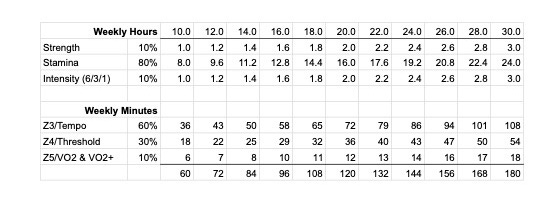The Ambitious Athlete's Guide to Allocating Intensity
Part One gave you a framework for allocating training load and structuring your week.
In this section, I'm going to offer you a framework for how to allocate training intensity.
Strength and stamina (above) are used in the colloquial sense.
Exercise physiologists have been debating the definition of each for as long as I've been alive.
Don't debate do!
Strength is relative.
to you
to the requirements of your sport
to your future self
to what can screw up tomorrow (we don't see injuries avoided)
There are many different types of strength, and training approaches.
Try them all
and include the following in your strength definition:
Traditional - compound lifts, pulls, pushes, twists (thread to get you started)
Plyometric exercises (stress your connective tissues)
Balance & agility exercises (prepare to avoid falling)
Different movement patterns
For a long time (25+ years), I had a very simple strength program. This period included some speedy race results and worked just fine.
In my late-40s, I started skiing and wanted new input to protect my joints and prepare for the demands of mogul skiing.
I started using MtnTactical.com programs.
The "programer" is not aware of my background load:
I scale the sessions (downwards) to fit into my strength allocation for the week
I spread the sessions out to avoid too much load in a week
The benefit of using someone else's program is variety. For me, the only way to make that happen is someone else designing the program.
Your personal tolerance for strength will vary over time. The 10% guideline is a minimum. Many athletes will tolerate, and benefit from, a greater emphasis on strength (particularly in the winter).
I score traditional strength at 1 TSS point per minute and plyometric/work capacity sessions at 2 TSS points per minute. These scores include rest periods.
When resting between work sets, do mobility work!
So that leaves us with Endurance Training
80% Stamina
6% Tempo
3% Threshold
1% VO2 & VO2+
I titled this piece with intent.
The Ambitious Athlete's Guide
I am assuming you truly want to see what's possible with regard to endurance sport.
I'm assuming you want long term gains rather than whatever payoff you're receiving from your current approach.
To see what's possible, you're going to have to overcome certain aspects of your Human Operating System and past habits.
One of these aspects is what I call "training like an age grouper" => instead of the 9% allocation to Tempo/Threshold we often have a burning desire to get that number closer to 90%!
Tempo/Threshold is what we expect exercise to feel like. Our breathing rate is up, we're sweating, the work rate is high... we think it's more beneficial.
Well, it is and it isn't.
The ability to benefit from "work rate" training is linked to our capacity to do, and recover from, work.
Stamina is our endurance capacity over time and fully developing this capacity takes years.
My article on A Swedish Approach to Athletic Excellence says more, including when it makes sense to decrease the total Stamina allocation.
Stamina Allocations
Within the 80%, let recovery guide your allocation between Zones 1 & 2.
From Part One, when you're having unplanned misses, assume...
Your training zones are set too high
Your loading days are too big
You have too many loading days
If you can't tolerate 80% of your week in Zone 1 and Zone 2 then:
Your zones are wrong - check LT1 via lactate (blog to come)
Your allocation to Zone 1 needs to increase - too much Zone 2
Your weekly hours need to decrease - load ramp too steep
You need to reduce total stress to accommodate training stress
It's usually a mix of the above, with spontaneous intensity additions, that tip us over the edge.
Suck it up, slow down, and build some stamina.
This protocol was the foundation for taking myself:
from a 60-minute standalone 10K
to winning Ultraman Hawaii
to a 2:46 Ironman marathon
Bookmark this post, when injuries and setbacks get you down, come back to it.
This is the way.
Back To Table of Contents



